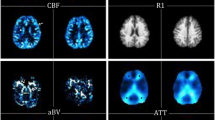Abstract
Object
The goal of this work is to use vessel encoded arterial spin labeling (VEASL) methods to detect feeding arteries without prior knowledge of their positions, and map the vascular territory of each.
Materials and methods
Five healthy subjects were scanned, each with four different tagging planes. The VEASL tagging method was modified to use 60 different pairs of encoding steps with random orientation and spacing. A signal model was developed to calculate the theoretical ASL signal resulting from a vessel in any position in the tagging plane. For each voxel, the location of the feeding vessel was estimated by finding the theoretical signal that correlates most closely with the data.
Results
The main intracranial arteries, including carotid, vertebral, basilar, and cerebral arteries above the Circle of Willis were identified and localized from the ASL data in all subjects. In addition, external carotid branches were detected in all subjects.
Conclusions
Randomly encoded VEASL provides data that allows for blind detection of source vessels. This method simplifies the VEASL prescription process and allows for efficient detection of atypical or collateral circulation.





Similar content being viewed by others
References
Davies NP, Jezzard P (2003) Selective arterial spin labeling (SASL): perfusion territory mapping of selected feeding arteries tagged using two-dimensional radiofrequency pulses. Magn Reson Med 49(6):1133–1142
Werner R, Norris DG, Alfke K, Mehdorn HM, Jansen O (2005) Continuous artery-selective spin labeling (CASSL). Magn Reson Med 53(5):1006–1012
Helle M, Norris DG, Rufer S, Alfke K, Jansen O, van Osch MJ (2010) Superselective pseudocontinuous arterial spin labeling. Magn Reson Med 64(3):777–786
Gunther M (2006) Efficient visualization of vascular territories in the human brain by cycled arterial spin labeling MRI. Magn Reson Med 56(3):671–675
Wong EC (2007) Vessel encoded arterial spin labeling using pseudo-continuous tagging. Magn Reson Med 58(6):1086–1091
Zimine I, Petersen ET, Golay X (2006) Dual vessel arterial spin labeling scheme for regional perfusion imaging. Magn Reson Med 56(5):1140–1144
Dai W, Garcia D, de Bazelaire C, Alsop DC (2008) Continuous flow-driven inversion for arterial spin labeling using pulsed radio frequency and gradient fields. Magn Reson Med 60(6):1488–1497
Gevers S, Bokkers RP, Hendrikse J, Majoie CB, Kies DA, Teeuwisse WM, Nederveen AJ, van Osch MJ (2011) Robustness and reproducibility of flow territories defined by planning-free vessel-encoded pseudocontinuous arterial spin-labeling. Am J Neuroradiol. doi:10.3174/ajnr.A2410
Jung Y, Rack-Gomer A, Wong E, Buracas G, Liu T (2009) Pseudo-continuous arterial spin labeling with optimized tagging efficiency for quantitative ASL fMRI. In: Proceedings 17th scientific meeting, ISMRM, Honolulu, p 1578
Jahanian H, Noll DC, Hernandez-Garcia L (2011) B(0) field inhomogeneity considerations in pseudo-continuous arterial spin labeling (pCASL): effects on tagging efficiency and correction strategy. NMR Biomed. doi:10.1002/nbm.1675
Jung Y, Wong EC, Liu TT (2010) Multiphase pseudocontinuous arterial spin labeling (MP-PCASL) for robust quantification of cerebral blood flow. Magn Reson Med 64(3):799–810
Wong EC, Guo J (2011) Blind detection of source vessel locations and resonance offsets using randomly encoded VEASL. In: Proceedings 19th scientific meeting, ISMRM, Montreal, p 294
Kansagra AP, Wong EC (2008) Mapping of vertebral artery perfusion territories using arterial spin labeling MRI. J Magn Reson Imaging 28(3):762–766
Kansagra A, Wong E (2009) Automated segmentation of multiple vascular territories from vessel encoded pseudo-continuous arterial spin labeling MRI data. In: Proceedings 17th scientific meeting, ISMRM, Honolulu, p 3652
Wong E, Kansagra A (2008) Mapping middle cerebral artery branch territories with vessel encoded pseudo-continuous ASL: sine/cosine tag modulation and data clustering in tagging efficiency space. In: Proceedings 16th scientific meeting, ISMRM, Toronto, p 182
Chappell MA, Okell TW, Jezzard P, Woolrich MW (2010) A general framework for the analysis of vessel encoded arterial spin labeling for vascular territory mapping. Magn Reson Med 64(5):1529–1539
Chappell MA, Okell TW, Jezzard P, Woolrich MW (2009) Vascular territory image analysis using vessel encoded arterial spin labeling. Med Image Comput Comput Assist Interv 12(Pt 2):514–521
Acknowledgments
This work was supported by Grant R01 EB002096 from the National Institutes of Health.
Author information
Authors and Affiliations
Corresponding author
Rights and permissions
About this article
Cite this article
Wong, E.C., Guo, J. Blind detection of vascular sources and territories using random vessel encoded arterial spin labeling. Magn Reson Mater Phy 25, 95–101 (2012). https://doi.org/10.1007/s10334-011-0302-7
Received:
Revised:
Accepted:
Published:
Issue Date:
DOI: https://doi.org/10.1007/s10334-011-0302-7




